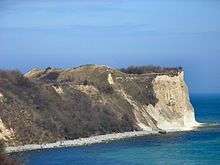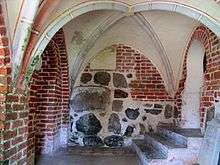Jaromarsburg
The Jaromarsburg was a cult site for the Slavic tribe of Rani dedicated to the god Svantovit and used from the 9th to the 12th century. It was located on the northeastern tip of the Baltic Sea island of Rügen at Cape Arkona, and was protected on two sides by the cliffed coast and from the land side by a Slavic burgwall. The name of the temple hill is derived from the Rani prince, Jaromar I, who became a vassal of the Danish king, Valdemar I in 1168 after Rügen was conquered by Denmark.

At Cape Arkona in recent centuries, sections of the cliff tops have continually collapsed into the sea, which is why the remnants of the Jaromarsburg today mainly comprise the castle ramparts. Based on a loss of 10 to 20 metres per century, it is believed that the current area within the ramparts represents only a third of the original total. As a result, for several years urgent archaeological excavations have taken place that have uncovered the site of the Svetovid temple, which had been thought for a long time had been lost to coastal collapse. It is a rectangular area that was completely free of artifacts, but to find around which, however, articles were discovered that may have been offerings, including parts of broken weapons. This is consistent with the historical account by Saxo Grammaticus, who states that the priests inside the temple were not even allowed to breathe within its confines, so as not to defile it.
Structure

The castle consisted of two successive ramparts that reached a height of 13 metres, plus additional fortifications. The fortifications and the temple were made of wood. Originally, the fortifications extended 300 metres on a north-south axis and 350 metres east-west. According to the Danish historian Saxo Grammaticus, the temple was surrounded by two enclosures, the outer one covered by a purple roof. Inside was a four-metre-high statue of Svetovid, carved from an oak trunk. Saxo Grammaticus writes: In its right hand the figure held a drinking horn, made of various metals. The priest filled it each year with mead and from that which had been lost over the year prophesied about the coming harvest .
It is believed that settlements related to the temple were located on the sites where today the fishing villages of Vitt and Putgarten now stand. The name of the latter means "at the foot of the castle".
History

From about the 9th century the Rani settled on Rügen; they probably built the sanctuary at this time and then erected the castle and fortifications in several stages.[1] In the 11th century the rampart was raised further using soil from the inner area of the castle. The Rani dominated Rügen for some time and the temple increased in importance as a religious centre for the Slavs in the southern Baltic following the destruction of Rethra in 1068. The temple served as oracle site and received offerings from other peoples, not just the Slavs.
But as early as 1136, a Danish army under King Eric the Memorable had captured the temple fortress. The defeated Rani pledged the adoption of Christianity but reneged on their agreement after the withdrawal of the Danes. In 1157, a storm destroyed a Slavic fleet of 1,500 ships off the Norwegian coast. The Danish king, Waldemar I, made used of this weakness to mount an offensive against Rügen, which was the stronghold of the Rani. After a series of attacks, ambushes and partial victories, he landed at Arkona with his fleet on 19 May 1168, accompanied by his army commander and close friend, Bishop Absalon. On 15 June 1168, the temple fortress was taken after four weeks of siege, when the attackers succeeded by day, in starting a fire at an unobserved point, which the defenders of the castle could not put out due to a shortage of water. The temple was then destroyed, the Svetovid statue chopped up and burned.
After the fall of the temple the princes of the Rügen Slavs, Tetzlav, who until then was the king of Rani, and his brother, Jaromar, who lived in their capital at Charenza, submitted to the Danish king. After the death of Tetzlav in 1170, Jaromar was Prince of the Rani until 1218. With the fall of the temple, King Valdemar got his hands on a treasure, but in 1171, he had to share this with his ally, Henry the Lion. The extensive estates of the temple were given to the Church.
In 1169 Rügen came under the suzerainty of the bishops of Lund, who oversaw the spread of Christianity. Numerous chapels were built on former cult and burial places. In the area of the former Svetovid sanctuary, the first Christian church was built on Rügen. In the nearby church of Altenkirchen, the building of which had probably already begun by 1185, is the Priest Stone (Priesterstein) or Svantevit Stone (Svantevitstein) – just above the foundation base – which is laid on its side. There are different interpretations of this stone. It is possible that the stone relief was carved in the pre-Christian era on Rügen, and could have represented the Slavic god, Svantevit, to the priest, because only he had the right to touch the large and ornate drinking horn of Svantevit's. But it could also be the gravestone of Prince Tetzlav, who had been given the peninsula of Wittow, after the Danish conquest of Rügen. Furthermore, it is assumed that the position of the stone represents the superiority of God over the pagan gods.
Archaeological investigations
The Jaromarsburg at Arkona is the only rampart for which we have detailed contemporaneous accounts. The castle was investigated by archaeologists multiple times due to the erosion constantly occurring around the castle. An information board in the Archaeological exhibition in Schwerin in 1995 showed this very clearly. The castle area has decreased in 1000 years to 1/3 of its original size.
This led the archaeologists to investigate the castle before it disappeared completely in the sea. Carl Schuchardt, an archaeologist from Berlin, undertook in 1921 the first known investigation. An important finding was that the written reports of the Saxos were correct and the space around the temple as a place of worship was empty. The west of the temple showed a smaller, but now leveled Wall, behind the big Wall which showed the living area. Whether that was meant for the cult priests and their servants or as a refuge for the surrounding settlements as well as a craft store, could not be determined until today.
In 1930, Wilhelm Petzsch investigated the wall and documented the findings. The most important result was that he found the fight film from 1136 (conquest by Danish King Erich II) under the combat and fire layer from 1168 (Danish King Waldemar I.). A deeper burnt layer was still present, which he dated to 1000.
Literature
- Petzsch-Martiny: Wall and gate of temple festivals Arkona. Prähist. Journal XXI, p 237 ff u. 262, 1930
- Carl Schuchhardt : Arkona, Rethra, Vineta. Berlin 1926th
- Petzsch: A Viking Fund of Arkona. In: Releases the antiquities collection Greifswald. Volume VII, 1935
- Astrid Tummuscheit: The stove all errors – The Tempelburg Arkona on the northern tip of Rügen. In: . Archaeological discoveries in Mecklenburg-Vorpommern(= . Archaeology in Mecklenburg-Vorpommern Band 5), State Office for Culture and Preservation, Schwerin 2009, p 157 ff,
References
- Torsten Kempke: Skandinavisch-slawische Kontakte an der südlichen Ostseeküste im 7. bis 9. Jahrhundert, in Ole Harck, Christian Lübke (Hrsgg.): Zwischen Reric und Bornhöved. Die Beziehungen zwischen den Dänen und ihren slawischen Nachbarn vom 9. bis ins 13. Jahrhundert (Forschungen zur Geschichte und Kultur des Östlichen Mitteleuropa, vol. 11), Stuttgart 2000, pp. 9–22, esp. p. 14; Heike Reimann, Fred Ruchhöft, Cornelia Willich: Rügen im Mittelalter. Eine interdisziplinäre Studie zur mittelalterlichen Besiedlung auf Rügen (Forschungen zur Geschichte und Kultur des Östlichen Mitteleuropa, vol. 36), Stuttgart 2011, pp. 42 ff.
External links
| Wikimedia Commons has media related to Jaromarsburg. |
- Die Gardvogteien Wittow und Jasmund Website with information on Cape Arkona including the Jaromarsburg
- Artist's impression of the castle in medieval times